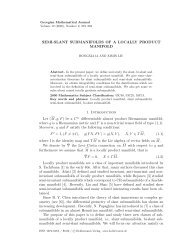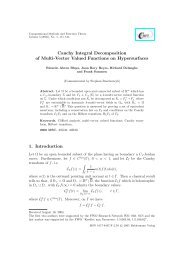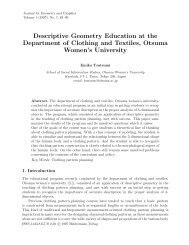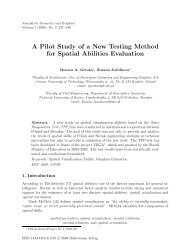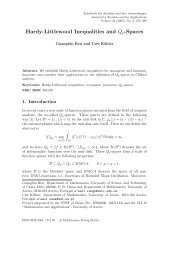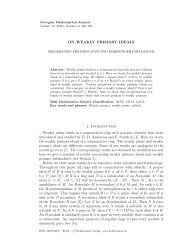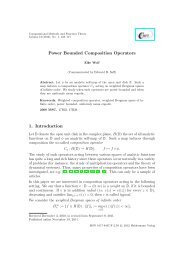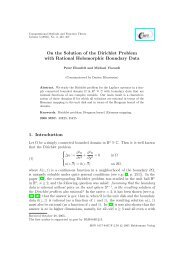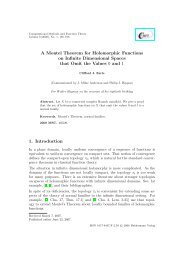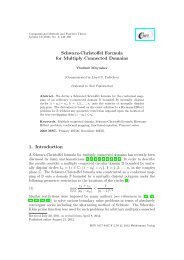Function Spaces as Dirichlet Spaces (About a Paper by Maz'ya and ...
Function Spaces as Dirichlet Spaces (About a Paper by Maz'ya and ...
Function Spaces as Dirichlet Spaces (About a Paper by Maz'ya and ...
You also want an ePaper? Increase the reach of your titles
YUMPU automatically turns print PDFs into web optimized ePapers that Google loves.
<strong>Function</strong> <strong>Spaces</strong> <strong>as</strong> <strong>Dirichlet</strong> <strong>Spaces</strong> 17<br />
Proof. We begin with the elementary remark that 1 − e −x ∼ x/(1 + x) for all<br />
x 0. Therefore, we find<br />
∫ ∞<br />
(<br />
f(r) =<br />
πn/2<br />
4 Γ ( 1 − e<br />
)<br />
−rλ ∫ ∞<br />
[ ∫ 1 (<br />
exp − 1 − t ) ] ) ρ(ds)<br />
t n/2−1 dt dλ .<br />
n<br />
2 0 λ 2 0+ 0 4sλ<br />
s<br />
∫ ∞<br />
( ∫ ∞<br />
[ ∫ 1<br />
rλ<br />
(<br />
∼<br />
0 0+ 0 1 + rλ exp − 1 − t ) ] ) ρ(ds)<br />
t n/2−1 dt dλ<br />
4sλ<br />
s<br />
∫ ∞<br />
( ∫ ∞<br />
[ ∫ 1<br />
r x (<br />
s<br />
=<br />
0 0+ 0 1 + r x exp − 1 − t ) ] ) dx<br />
t n/2−1 dt ρ(ds)<br />
4x<br />
x<br />
s<br />
2<br />
∫ ∞<br />
( ∫ 1<br />
[ ∫ ∞<br />
]<br />
rx<br />
(<br />
=<br />
0 0 0+ s + rx ρ(ds) exp − 1 − t ) ) dx<br />
t n/2−1 dt<br />
4x<br />
x 2<br />
{ ∫ 1 ∫ ∞<br />
}( ∫ 1 (<br />
= +<br />
g(rx) exp − 1 − t ) ) dx<br />
t n/2−1 dt<br />
4x<br />
x 2<br />
0<br />
=: I 1 + I 2 .<br />
1<br />
We will estimate I 1 <strong>and</strong> I 2 separately.<br />
∫ ∞<br />
( ∫ 1<br />
I 2 =<br />
r<br />
c 1 r<br />
r<br />
∫ ∞<br />
r∫ ∞<br />
r<br />
0<br />
0<br />
(<br />
g(y) exp −<br />
g(y) dy ∫ 1<br />
t n/2−1 dt<br />
y 2<br />
0<br />
g(y) dy<br />
y 2 .<br />
(1 − t)r<br />
) ) r dy<br />
t n/2−1 dt<br />
4y<br />
y 2<br />
On the other h<strong>and</strong>, we find<br />
∫ ∞<br />
( ∫ 1 (<br />
(1 − t)r<br />
) ) r dy<br />
I 2 = g(y) exp − t n/2−1 dt<br />
r 0<br />
4y<br />
y 2<br />
∫ ∞<br />
( ∫ 1<br />
) dy<br />
r g(y)e −1/4 t n/2−1 dt<br />
so that<br />
c 2 r<br />
r<br />
∫ ∞<br />
r<br />
0<br />
g(y) dy<br />
y 2 ,<br />
I 2 ∼ r<br />
Let us now estimate I 1 . We have<br />
∫ 1<br />
( ∫ r<br />
I 1 =<br />
0 0<br />
∫ r<br />
( ∫ 1<br />
= 4<br />
0<br />
0<br />
∫ ∞<br />
r<br />
(<br />
g(y) exp −<br />
r<br />
(<br />
4y exp −<br />
g(y) dy<br />
y 2 .<br />
y 2<br />
(1 − t)r<br />
)<br />
t n/2−1 r dy<br />
4y<br />
)<br />
(1 − t)r<br />
4y<br />
)<br />
t n/2−1 dt<br />
)<br />
dt<br />
y 2<br />
g(y) dy<br />
y .



